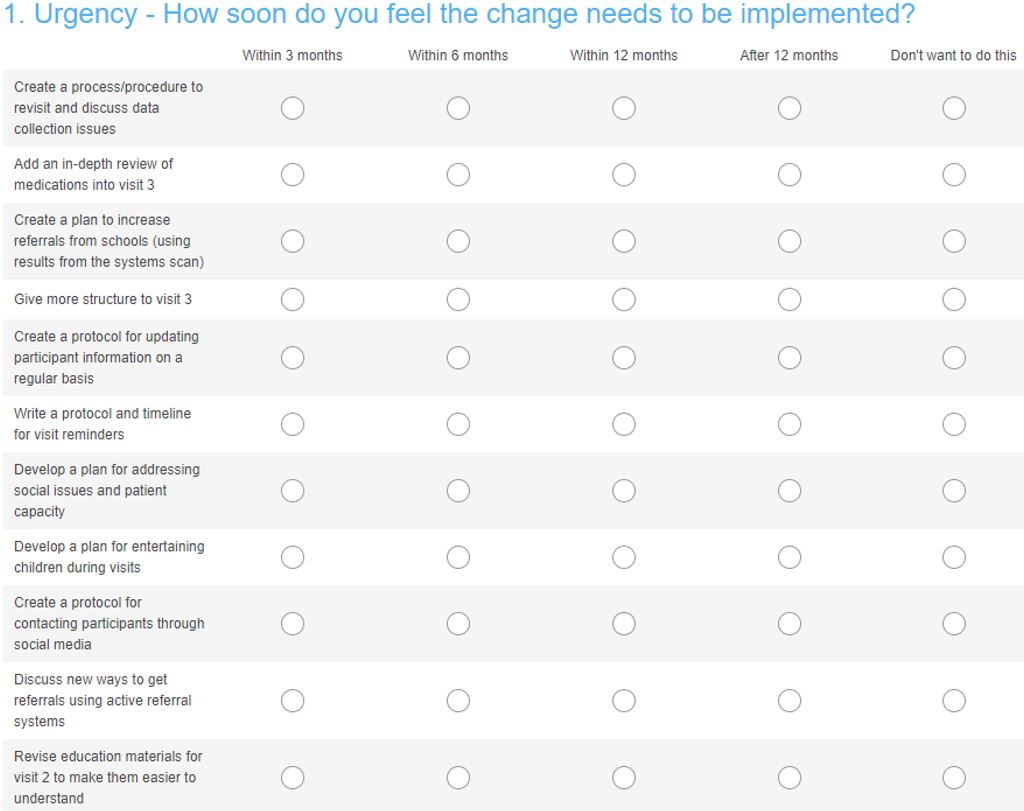Hi, I’m Kellie Baxter with the Utah Asthma Program. I coordinate the Utah Asthma Home Visiting Program, an in-home asthma education program. Six months after the launch of this program, our Evaluator Holly Uphold completed a process evaluation to help improve implementation of the program. The evaluation produced many recommendations. Implementing all of these recommendations felt daunting for a program in its infancy with newly trained staff still getting their bearings! Our solution? A post-evaluation action plan.
We started by dedicating a portion of our monthly partner meetings to evaluation. We reviewed the recommendations with stakeholders and reached a consensus about which recommendations should be implemented. From there, we created an action plan that could address all the recommendations without overwhelming staff implementing the program.
Hot Tip: Use stakeholders to help prioritize evaluation findings before writing your action plan. This will help increase stakeholder buy-in and guide the focus and timeline for implementing evaluation findings. We went through a number of prioritization processes to develop our action plan:
- As coordinator for the program responsible for implementing these changes, I started by separating out the recommendations that I could easily do myself (e.g. minor changes to data collection forms), and which recommendations required stakeholder input (e.g. changes to program curriculum, format, or referral processes). This decreased the number of recommendations that needed to be prioritized.
- After completing this process, we developed criteria for initial prioritization. Some of the criteria we considered included:
- Perceived benefit or impact (How much will this change benefit or impact the program participants? How much will this change benefit or impact the local health departments implementing the program?)
- Importance (How important is this change to program operation?)
- Urgency (How soon does this change need to be implemented?)
- Effort to implement the change (How much effort is required to make this change?)
Cool Trick: Use an online survey to streamline the prioritization process. Stakeholders were given an online survey and asked to complete it before the next monthly meeting. This survey listed the recommendations to be implemented and required that stakeholders rank them by the evaluation criteria. This helped identify areas of consensus among stakeholders and further narrowed the list of recommendations that had to be discussed and prioritized in person.
Results from the survey were presented at the monthly partner meeting. Recommendations that didn’t have clear consensus from the survey were discussed in-person during a group prioritization activity.
Rad Resource: Techniques like an Impact Effort Matrix or the NACCHO Guide to Prioritization Techniques can help guide your group prioritization discussion.
Using the results from these prioritization activities, an action plan was created and each recommendation was assigned a timeline and lead person. Progress on the action plan was reviewed at monthly meetings.
Hot Tip: Creating the action plan as an online shared document will help stakeholders keep track of the recommendations, who is responsible, and the deadlines.
The American Evaluation Association is celebrating Post Evaluation Action Planning Week. All posts this week are contributed by evaluators who came together to write about a simple, but rarely-used tool for encouraging the use of evaluation findings by decision-makers – the action plan. Do you have questions, concerns, kudos, or content to extend this aea365 contribution? Please add them in the comments section for this post on the aea365 webpage so that we may enrich our community of practice. Would you like to submit an aea365 Tip? Please send a note of interest to aea365@eval.org . aea365 is sponsored by the American Evaluation Association and provides a Tip-a-Day by and for evaluators.



“Use stakeholders to help prioritize evaluation findings before writing your action plan. ”
That recommendation brought tears to my eyes.
We hardly ever ask stakeholders what they think.
We fall in love with our pet recommendations and priorities and then wonder why implementation is so rocky.
We need more cool tools like this.
Hi Kellie,
Thanks for sharing your evaluation process as it pertains to the Utah Asthma program.
In my experience any time a project on this scale is rolled out – evaluating it can be challenging.
I really liked the idea of engaging stake holders prior to meetings, specifically online. I think that this allows for stakeholders to complete the surveys on their own time (which may increase response rates) and allows you a way to collect data easily. I am definitely going to utilize this in my next evaluation process.
Have you thought about engaging participants of the study in the same manner to see if the program has been helpful (if you haven’t already)?